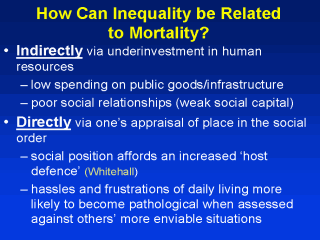| front |1 |2 |3 |4 |5 |6 |7 |8 |9 |review |
 |
These categories are
necessarily overly simplistic but are still useful. In the Kaplan study looking at the 50 U.S. states, they found that inequality was also related to spending on education, violent crime, number of library books per capita. Societies with wider income distributions also tend to have weak social ties and poor community life - or to borrow Coleman’s term, they have weak social capital. The second mechanism has to do with one’s appraisal of place in the social order. Even if you live in a society where all your basic needs are met, if there are large income differentials, you will perceive yourself as being more deprived than would someone with even lower absolute income living in a poorer but more egalitarian society. To quote a Globe and Mail article from Tuesday this week “Poverty is worse in the United States than it is in Namibia. In the U.S. they know the difference.” The argument follows that prolonged exposure to a society where there’s a big difference in terms of lifestyle, choices and control between those on the top and those on the bottom is stressful and directly health damaging, especially to those on the bottom. |